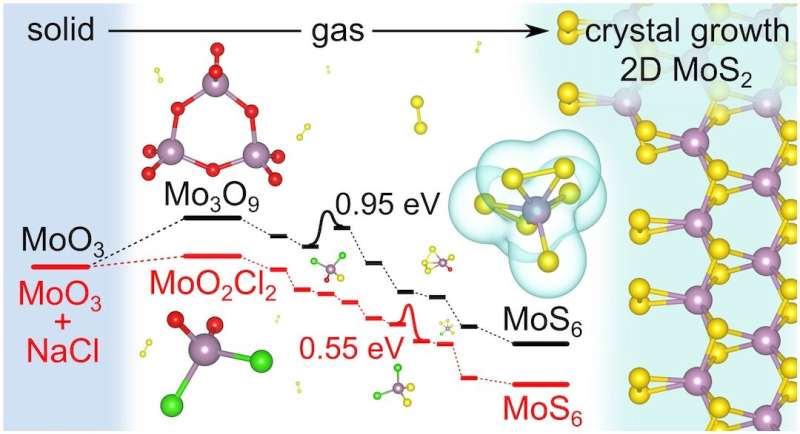Study details why 2D molybdenum disulfide formation gets a speed boost from salt

Skipping ahead in a line is rude, but sometimes it's acceptable. Especially for salt.
The Rice University lab of materials theorist Boris Yakobson shows why in its follow-up to a 2018 study that demonstrated how salt simplifies the formation of valuable 2D molybdenum disulfide (MoS2) with a first-principles analysis of the process that could refine it even further.
The theoretical study by Yakobson and colleagues Jincheng Lei, Yu Xie and Alex Kutana, all alumni of his lab, and researcher Ksenia Bets shows through the simulation of atom-level energies why salt—particularly iodized salt—lowers the reaction temperature in a chemical vapor deposition (CVD) furnace necessary to form MoS2.
It does so by helping to skip some steps and leap high energy barriers in conventional CVD growth to yield far more MoS6, an essential precursor to 2D MoS2.
Their study in the Journal of the American Chemical Society focused on how salt lowers activation barriers to enhance the sulfurization of molybdenum oxyhalides, the gas feedstock in MoS2 crystallization.
MoS2 is a natural compound known in bulk form as molybdenite, and in 2D form is highly coveted for its semiconducting properties, which promise advances in electronic, optoelectronic, spintronic, catalytic and medical applications. But 2D MoS2 remains hard to manufacture in commercial quantities.
The Rice team first entered the fray when labs in Singapore, China, Japan and Taiwan used salt to make a "library" of 2D materials that combined transition metals and chalcogens. Why it worked so well was a mystery, prompting them to call upon the Yakobson lab's expertise in modeling materials—even only theoretical ones—from the ground up.
Their comprehensive models show that while the international labs used chloride salts to make their library of materials, the iodide salts commonly found on kitchen tables are better at speeding up the synthesis of MoS2.
"Fast and large-scale synthesis is imperative for the widespread application of MoS2," Lei said. "We carefully studied the entire growth process, hoping to optimize it as much as possible. It turned out that by simply changing chloride to iodide, one could synthesize MoS2 much faster while at even lower growth temperatures."
This happens when salt and the precursor form a eutectic, a mixture of substances that melt and solidify at a single temperature that's lower than the melting points of the constituents.
"After salt-assisted synthesis was shown to enable the growth of many more TMD (transition metal dichalcogenide) compounds than was possible beforehand and significantly improved growth conditions for previously synthesized ones, it became clear that there is something special about this process," Bets said.
"Some experimental groups attempted to investigate further, but monitoring the molecular composition of the gas phase under growth conditions is not a simple task," she said. "Even then, you cannot see the whole picture.
"We were very thorough, following up on Jincheng's work on the mechanism of conventional MoS2 growth. We simulated all parts of the process, from sulfurization to the 2D crystal growth. This comprehensive approach paid off."
In simulations, the Rice team directly observed the entire sulfurization process as oxygen and chlorine atoms were gradually replaced by sulfur in MoO2Cl2, a common precursor, under CVD conditions.
The lab said the eutectic effect may be a common phenomenon in the CVD synthesis of 2D dichalcogenide monolayers, and thus worth continued study.
More information: Jincheng Lei et al, Salt-Assisted MoS2 Growth: Molecular Mechanisms from the First Principles, Journal of the American Chemical Society (2022). DOI: 10.1021/jacs.2c02497
Journal information: Journal of the American Chemical Society
Provided by Rice University





















